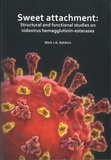Sweet attachment
Structural and functional studies on nidovirus hemagglutinin-esterases

Bakkers, Mark
- Promoter:
- Prof.dr. F.J.M. (Frank) van Kuppeveld
- Co-promoter:
- Dr. R.J. (Raoul) de Groot
- Research group:
- Kuppeveld
- Date:
- March 15, 2017
- Time:
- 14:30 h
Summary
We studied the attachment of nidoviruses (toro- and group 2a betacoronaviruses) to O-acetylated Sias as a paradigm for virus-Sia interactions. These viruses possess envelope glycoproteins, hemagglutinin-esterases (HEs), that mediate reversible virion attachment to O-acetylated Sias through the concerted action of lectin and receptor-destroying enzyme (sialate-O-acetylesterase) domains. The precise role and mechanism of HE in the natural infection and transmission of these viruses remains largely unknown.
Using a multidisciplinary approach, entailing molecular virology, structural biology, glycobiology, and animal experimentation, we aimed to answer the following questions. What is the structural basis for the differences in receptor specificity and affinity and what are the implications of these differences for virus adhesion dynamics and for the course of the infection? Besides structure elucidation of a number of corona- and torovirus HEs in complex with their receptor, we also developed a small animal model that closely mimics natural enteric MHV infection. This animal model, in combination with extensive in vitro data and an up-and-running reverse genetics system, allows us to study the consequences of viral adaptation to specific sialic acid subtypes as receptor determinants in unprecedented detail.